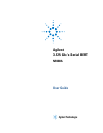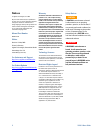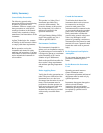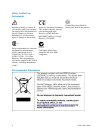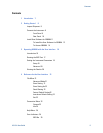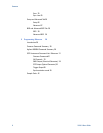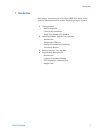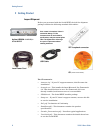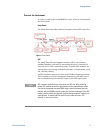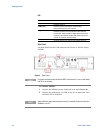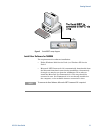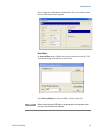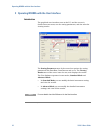Safety Summary
General Safety Precautions
The following general safety
precautions must be observed during
all phases of operation of this
instrument. Failure to comply with
these precautions or with specific
warnings elsewhere in this manual
violates safety standards of design,
manufacture, and intended use of the
instrument.
Agilent Technologies Inc. assumes
no liability for the customer's failure
to comply with these requirements.
Before operation, review the
instrument and manual for safety
markings and instructions. You must
follow these to ensure safe operation
and to maintain the instrument in
safe condition.
General
This product is a Safety Class 1
instrument (provided with a
protective earth terminal). The
protective features of this product
may be impaired if it is used in a
manner not specified in the
operation instructions.
All Light Emitting Diodes (LEDs)
used in this product are Class 1
LEDs as per IEC 60825-1.
Environment Conditions
This instrument is intended for
indoor use in an installation category
II, pollution degree 2 environment. It
is designed to operate at a maximum
relative humidity of 95% and at
altitudes of up to 2000 meters.
Refer to the specifications tables for
the ac mains voltage requirements
and ambient operating temperature
range.
Before Applying Power
Verify that all safety precautions are
taken. The power cable inlet of the
instrument serves as a device to
disconnect from the mains in case of
hazard. The instrument must be
positioned so that the operator can
easily access the power cable inlet.
When the instrument is rack
mounted the rack must be provided
with an easily accessible mains
switch.
Ground the Instrument
To minimize shock hazard, the
instrument chassis and cover must
be connected to an electrical
protective earth ground. The
instrument must be connected to the
ac power mains through a grounded
power cable, with the ground wire
firmly connected to an electrical
ground (safety ground) at the power
outlet. Any interruption of the
protective (grounding) conductor or
disconnection of the protective earth
terminal will cause a potential shock
hazard that could result in personal
injury.
Do Not Operate in an Explosive
Atmosphere
Do not operate the instrument in the
presence of flammable gases or
fumes.
Do Not Remove the Instrument
Cover
Operating personnel must not
remove instrument covers.
Component replacement and internal
adjustments must be made only by
qualified personnel.
Instruments that appear damaged or
defective should be made
inoperative and secured against
unintended operation until they can
be repaired by qualified service
personnel.



